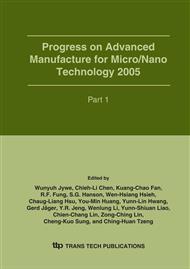p.25
p.31
p.37
p.43
p.49
p.55
p.61
p.67
p.73
Development of Pressure Technique of Brake Nanofluids from an Arc Spray Nanoparticles Synthesis System
Abstract:
The low-pressure control methods for an arc-submerged nanoparicle synthesis system (ASNSS) was proposed and developed for brake nanofluids. In the process, a copper bar is melted and vaporized in insulating liquid for core formation with crystallization suppressed to derive nanofluid that contains nanometer copper particles in DOT3 brake fluid. Two technical advances associated with nanoparticle synthesis were achieved. One is the novel pressure control technique developed for nanoparticle fabrication. The other is the verification that the constant low-operating pressure. Pressure operating plays important role in determining the characteristics of the prepared nanoparticles in brake fluids. From the experimental processes, pressure control of the ASNSS was identified as crucial to success of nanoparticles synthesis. To achieve the desired pressure control, a vacuum chamber was developed as a nanoparticle accumulator and low-pressure reservoir. The chamber was controlled by the proposed flow –valve feedback control system and integrated with the ASNSS. The pressure control equipment of the ASNSS was effectively developed to prepare desired copper-oxide brake nanofluids with well-controlled size.
Info:
Periodical:
Pages:
49-54
Citation:
Online since:
January 2006
Authors:
Price:
Сopyright:
© 2006 Trans Tech Publications Ltd. All Rights Reserved
Share:
Citation:


